Serviços Personalizados
Artigo
Links relacionados
Compartilhar
RSBO (Online)
versão On-line ISSN 1984-5685
RSBO (Online) vol.11 no.3 Joinville Jul./Set. 2014
ORIGINAL RESEARCH ARTICLE
Evaluation of postoperative pain in endodontically treated teeth
Ademar Luís Waskievicz I; Flávia Baldissarelli II; José Roberto Vanni II; José Roberto Vanni I,III; Caroline Solda III,IV; Mateus Silveira Martins Hartmann II; Volmir João Fornari II
I School of Dentistry of Meridional School – Passo Fundo – RS – Brazil
II Department of Endodontics of School of Dentistry and Post-Graduation of Meridional School – Passo Fundo – RS – Brazil
III Post-Graduation in Endodontics, Meridional Center of Dentistry Studies – Passo Fundo – RS – Brazil
IV IMaster Course in Dentistry of Lutheran University of Brazil – Canoas – RS – Brazil
ABSTRACT
Introduction: The success of endodontic treatment is directly related to the morphology domain and endodontic infection control. Some factors such as procedural errors (instrumentation, obturation apical deviations and perforations) can cause postoperative pain. Objective: This study aimed to evaluate postoperative pain in endodontically treated teeth at Dentistry Post-graduation Clinic of Meridional School (IMED/CEOM), Passo Fundo/Brazil from January 2010 to June 2013. Material and methods: The study was approved by the Institutional Review Board. After collection, data were analyzed regarding the occurrence of postoperative pain. This research is a quantitative cross-sectional study, whose sample comprised 302 medical records of patients undergoing endodontic treatment from a non-probability sampling. The review of follow-up appointment charts was carried out by the researcher. Results: During the research period and analysis of 302 medical records, 30.80% showed postoperative pain. However, 69.20 % did not feel any pain. Conclusion: It can be concluded that the pain was more frequent when associated with vital pulp, and these data are relevant to the dental clinic.
Keywords: Endodontics; postoperative pain; root canal therapy.
Introduction
The goal of endodontic treatment is to provide conditions so that periapical tissues normality can be reestablished. Such conditions occur through root canal cleaning and shaping that promotes disinfect ion maintenance. Thus, endodont ic treatment is based on two fundamental principles: domain of tooth morphology and control of infection. Access to pulp chamber, main canals, dentinal tubules and ramifications accounts for controlling the infection through cleaning and disinfection of root canals 12.
Importantly, one should know the postoperative pain causes and whether postoperative pain may be involved with number of appointments, so that preventive measures would be adopted to reduce significantly the incidence of this highly disturbing, clinically undesirable phenomenon 10.
Moreover, other factors should be taken into consideration in choosing the treatment modality to be performed, such as: dentists' technical skills and clinical expertise; tooth conditions; morphologic and biological considerations; patient's postoperative period; and mainly proper cleaning and disinfection of root canal system 6.
Therefore, the aim of this study was to evaluate postoperative pain in teeth endodontically treated by students of the Course of Specialization in Endodontics at the Dentistry Post-graduation Clinics of the School of Dentistry of Meridional School (Imed/Ceom), Passo Fundo/Brazil, from January 2010 to June 2013.
Material and methods
Study design and sample size
This is a quantitative comparative study. This present study was submitted and approved by the Institutional Review Board (protocol no. 262.941, CAAE no. 08988612.4.0000.5319). Three hundredtwo files of patients submitted to endodontic treatment by students of the Course of Specialization in Endodontics at the Dentistry Post-graduation Clinics of the School of Dentistry of Meridional School (Imed/Ceom), Passo Fundo/Brazil, from January 2010 to June 2013.
Procedures
All files of patients undergoing endodontic treatment who had a follow-up appointment from January 2010 to June 2013 were collected by a single examiner. The patients responded whether they had pain, and if positive, which had been the pain intensity. The study analyzed how many patients exhibited postoperative pain. Data collected were recorded in tables and analyzed regarding the number of patients reporting pain.
Results
The results are expressed in table 1 to 6.

Of the 302 files collected during the study period, 93 (30.80%) presented information of symptomat ic pat ients and 209 (69.20%) of asymptomatic patients.
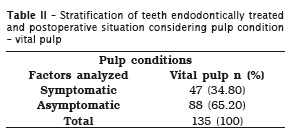
Considering the pulp condition, 135 endodontic treatments (ETs) were performed in vital pulp with 47 symptomatic patients (34.80%) and 88 (65.20%) asymptomatic patients.
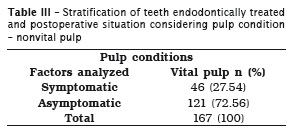
With regard to nonv ital pulp, 167 ETs were carried out, of which 121 (72.56%) were asymptomatic and 46 (27.54%) symptomatic.
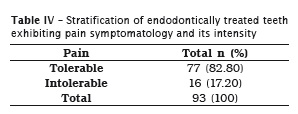
Of the 93 cases exhibiting symptomatology (pain), 77 cases (82.80%) were tolerable and only 16 cases (17.20%) intolerable.
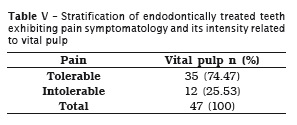
Of the 47 cases of endodontic treatment carried out in vital pulp, 35 (74.47%) presented tolerable postoperative pain and 12 (25.53%) intolerable postoperative pain.
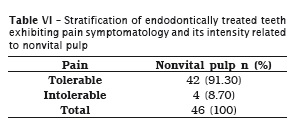
Of the 46 cases of endodontic treatment carried out in nonvital pulp, 42 (91.30%) showed tolerable postoperative pain and 4 (8.70%) intolerable postoperative pain.
Discussion
One of the problems when studying pain is the difficulty in evaluation because the threshold range, single and variable experience, pain modulation by many physical and psychological factors account for confusion both for patients and professional. Many techniques have been used to assess pain intensity in human beings and described in the literature, such as verbal, numerical, visual analog, colored analogue, and finger-reach rating scales; calibrated questionnaires; and cortical evoked potentials 5.
This present study aimed to assess postoperative pain in endodontically treated teeth. Three hundredtwo files of patients followed-up after endodontic treatment were analyzed, and at that moment, the patients responded whether they had or had not suffered postoperative pain. If positive, a numerical rating scale ranging from 1 to 4 (tolerable) and from 5 to 9 (intolerable) was used.
Of the 302 files analyzed, 93 patients (30.80%) reported any type of postoperative pain and 209 (69.20%) reported they had not felt any pain.
Of the 93 patients felling pain, considering pulp condition, 47 of endodontic treatments (50.54%) were carried out in vital pulp and 46 (49.46%) in nonvital pulp.
With regard to pulp intensity, generally, 77 patients (82,80%) had suffered tolerable and 16 (17,20%) intolerable pain.
When relating pain intensity with pulp condition, of the 47 patients with endodontic treatment on vital pulp, 35 reported tolerable pain (74.47%) and 12 intolerable pain (25.53%). Of the 46 cases reporting pain after endodontic treatment on nonvital pulp, 42 (91.30%) had suffered tolerable and 4 (8.70%) intolerable pain. Of these 93 patients reporting any pain symptomatology, intolerable pain requiring medication occurred more often in vital pulp.
Gotler, Bar-Gil and Ashkenazi 3 also found that endodontic treatment on vital pulp exhibited significantly more incidence and intensity of postoperative pain than that on either nonvital pulp or retreated teeth, corroborating the findings of this present study.
Other study evaluating postoperative pain incidence in endodont ic treatments on vital and nonvital pulp concluded that postoperative prevalence was not different regarding to pulp conditions. Most of patients reported lack of pain or mild pain 4.
Mild pain or sensitivity is a fast, tolerable pain that decreases over time. Consequently, the patients are not able to report exactly what they are feeling. Many factors may cause this pain, such as: the pressure exerted by dental clamps; and modus of anesthetic injection, which may injure the site and cause postoperative discomfort. Even the endodontic treatment itself may cause mild pain or sensitivity.
The results of this present study did not agree with those of the studies of Rigo, Petrini and Lodi 7, in which global postoperative pain was of 64.2% regardless of the pulp condition, probably because of the small sample size of only 141 files.
The study conducted by Walton 13 also reported findings similar to those of this present study, in which 49 patients (34.8%) of the 141 files evaluated exhibited any pain type. The authors affirmed that because the interaction between periapical tissues and microorganisms, the flare-up occurred more easily in nonvital pulp cases.
Farzana et al. 2, aimed to evaluate postoperative pain incidence in multi-appointment endodontic treatments on either vital or nonvital pulp of 52 teeth requiring treatment. The authors observed that mild to moderate pain occurred in 4.34% and 4.39% of vital pulp teeth, respectively; and 17.3% and 3.44% of nonvital pulp, respectively. This aforementioned study concluded that no significant difference was found in postoperative pain between vital and nonvital pulps.
With regard to postoperative pain intensity, this present study's results are similar to those of Risso et al. 8, who analyzed postoperative pain in teenagers undergoing one- or two-appointment endodontic treatment. Post-operative pain was verified through visual analog scale ranging from 0-5. These authors observed that pain frequency was of 10.5% (6 of 57 cases) in one-appointment group and 23% (14 of 61 cases) in two-appointment group; and global pain frequency was of 30%, similar to the results of this present study.
Singh and Garg 9, evaluated pain intensity in 200 patients aged from 20 to 60 years, who were instructed to put a mark on a horizontal scale to represent the intensity of pain experience. The authors concluded that postoperative pain incidence and intensity were gradually reduced over the study time without statistically significant differences. Similarly, other significant differences in pain levels between vital and nonvital pulp were not found. In this present study, vital pulp showed more severe pain, regardless of the number of appointments.
According to Elmubarak et al. 1, endodontic treatment is a common procedure in Dentistry that can lead to postoperative pain, regardless of pulp condition and number of appointments.
The prevalence of postoperative pain, so-called flare-up, is a factor that should not cause concern at the moment of clinical decision. Certainly, endodontic treatment with smaller postoperative pain rates is preferentially the treatment of choice, since decision does not compromise endodontic treatment effectiveness and costs 11.
Conclusion
Within the limits of this clinical study, it was observed that:
• of the total 302 f i les rev ised within the study period, 209 (69.20%) did not show any symptomatology;
• of 302 pat ients, 93 (30.8%) experienced postoperative pain, from whom 77 (82.8%) reported tolerable pain and 16 (17.2%) reported intolerable pain;
• of the 47 cases treated with vital pulp, 35 (74.47%) experienced tolerable postoperative pain and 12 (25,53%) experienced intolerable pain; of 46 cases treated with nonvital pulp, 42 (91.30%) experienced tolerable postoperative pain and 4 (8.70%) experienced intolerable pain. Thus, intolerable pain, when present, was associated with vital pulp and further studies are necessary aiming to evaluate postoperative pain.
References
1. Elmubarak HHA, Abu-Bakr NH, Ibrabim YE. Postoperative pain in multiple-visit and single-visit root canal treatment. Journal of Endodontics. 2010;36(1):36-9. [ Links ]
2. Farzana MF, Hossain SMI, Islam SMN, Rahman MA. Postoperative pain following multi-visit root canal treatment of teeth with vital and non-vital pulps. Journal of Armed Forces Medical College. 2010;6(2).
3. Gotler M, Bar-Gil B, Ashkenazi M. Postoperative pain after root canal treatment: a prospective cohort study. International Journal of Dentistry. 2012;ID 310467. 5 p.
4. Ince B, Ercan E, Dalli M, Dulgergil CT, Zorba YO, Colak H. Incidence of postoperative pain after single and multi-visit endodontic treatment in teeth with vital and non-vital pulp. European Journal of Dentistry. 2009;(3):273-9.
5. Levin LG, Law AS, Holland GR, Abbott PV, Roda RS. Identify and define all diagnostic terms for pulpal health and disease states. J Endod. 2009;35(12):1645-57.
6. Londhe CSM, Garge BHG. Single visit root canal treatment. Medical Journal of Zambia. 2007;63(3):273-9.
7. Rigo L, Petrini I, Lodi L. Dor pós-operatória em tratamento endodôntico realizado em sessão única e múltipla. International Journal of Dentistry. 2012;11(1):29-37.
8. Risso PA, Cunha AJLA, Araujo MCP, Luiz RR. Post obturation pain and associated factors in adolescent patients undergoing one- and twovisit root canal treatment. Journal of Dentistry. 2008;36(11):928-34.
9. Singh S, Garg A. Incidence of post-operative pain after single visit and multiple visit root canal treatment: a randomized controlled trial. Journal of Conservative Dentistry. 2012;15(4):323-7.
10. Siqueira JFJ. Microbial causes of endodontic flare-ups. International Endodontic Journal. 2003;36(7):453-63.
11. Silveira AMV, Lopes HP, Siqueira Jr JF, Macedo SB, Consolaro A. Periradicular repair after two-visit endodontic treatment using two different intracanal medications compared to single-visit endodontic treatment. Brazilian Dental Journal. 2007;18(4):299-304.
12. Souza SCA, Teles PR, Souto R, Chaves MAE, Colombo PV. Endodontic therapy associated with calcium hydroxide as an intracanal dressing: microbiologic evaluation by the checkerboard DNA-DNA hybridization technique. Journal of Endodontics. 2005;31(2):79-83.
13. Walton ER. Interappointment flare-up: incidence, related factors, prevention, and management. Endodontic Topics. 2002;3(1):67-76.
 Corresponding author:
Corresponding author:
Caroline Solda
Rua 14 de Julho, 247 – Bairro Rodrigues
CEP 99070-160 – Passo Fundo – RS – Brasil
E-mail: andre.carol@ibest.com.br
Received for publication: April 8, 2014
Accepted for publication: May 19, 2014













